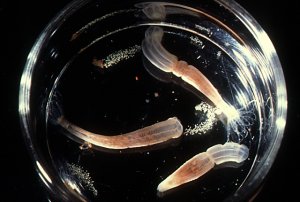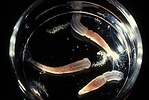Nematostella
- Nematostella vectensis Stephenson 1935
- Milne-Edwardsia polaris Carlgren 1921
- Milne-Edwardsia nathorsti Carlgren 1921
- Nematostella pellucida Crowell 1946
Characteristics
Edwardsiidae with the column divisible into physa, scapus, scapulus and capitulum, though these regions may be slightly distinguished. Scapus with or without adherent material, without nemathybomes and tenaculi. Tentacles 10-18, the outer longer than the inner. A single, ventral siphonoglyph. Mesenteries as in Edwardsia. Retractors in comparison with those of other Edwardsiidae rather weak. Ciliated tracts may be discontinuous. Curious, ciliated, spherical bodies, nematosomes, containing nematocysts occur in the coelenteron, in which they swim about. Cnidom: spirocysts, basitrichs, microbasic p-mastigophors.References
Carlgren, O. 1949. A Survey of the Ptychodactiaria, Corallimorpharia and Actiniaria. Kungl. Svenska Vetenskapsakadamiens Handlingar, series 4, volume 1, number 1.
Title Illustrations

Nematostella vectensis with egg masses.
Photo copyright © 2000, Ron Ates.
Permission by Prof. C. Hand to take this picture in the Bodega Marine Lab, University of California is gratefully acknowledged.
About This Page
The information provided on this page is based on Oscar Carlgren's 1949 catalog.Copyright © 1949 Swedish Academy of Sciences.
Please note that Carlgren's text contains a number of errors, and much of the information is now out of date. An update of the catalog is currently under preparation in Daphne Fautin's laboratory, and the results of this work will be incorporated in future versions of this page.
Keyboarding of Carlgren's catalog was done as part of a project to create an electronic database of the sea anemones of the world, funded by NSF Grant DEB9521819, awarded to Daphne G. Fautin. This grant is in the program Partnerships to Enhance Expertise in Taxonomy (PEET). Susanne Hauswaldt, Katherine Pearson, and April Wakefield-Pagels contributed to the keyboarding effort.
Correspondence regarding this page should be directed to Daphne G. Fautin at
fautin@ku.edu
Page copyright © 2000
All Rights Reserved.
Citing this page:
Tree of Life Web Project. 2000. Nematostella. Version 01 January 2000 (temporary). http://tolweb.org/Nematostella/17796/2000.01.01 in The Tree of Life Web Project, http://tolweb.org/








 Go to quick links
Go to quick search
Go to navigation for this section of the ToL site
Go to detailed links for the ToL site
Go to quick links
Go to quick search
Go to navigation for this section of the ToL site
Go to detailed links for the ToL site